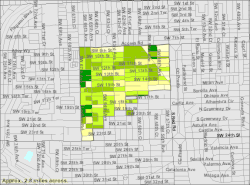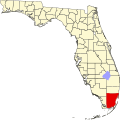West Miami, Florida | |
|---|---|
| City of West Miami | |
| Motto: | |
 Location in Miami-Dade County and the U.S. state of Florida | |
 U.S. Census Bureau map showing city limits | |
| Coordinates: 25°45′26″N80°17′48″W / 25.75722°N 80.29667°W | |
| Country | |
| State | |
| County | Miami-Dade |
| Incorporated | April 7, 1947 |
| Government | |
| • Type | Council-Manager |
| • Mayor | Eric Diaz-Padron |
| • Vice Mayor | Juan M. Blanes |
| • Commissioners | Candida Blanca, Luciano L. Suarez, and Ivan Chavez, Jr. |
| • City Manager | Edward Silva |
| • City Clerk | Annery Gonzalez |
| Area | |
• Total | 0.71 sq mi (1.84 km2) |
| • Land | 0.71 sq mi (1.84 km2) |
| • Water | 0.00 sq mi (0.00 km2) |
| Elevation | 9 ft (3 m) |
| Population | |
• Total | 7,233 |
| • Density | 10,201.69/sq mi (3,939.14/km2) |
| Time zone | UTC-5 (Eastern (EST)) |
| • Summer (DST) | UTC-4 (EDT) |
| ZIP codes | 33144, 33155 (Miami) |
| Area codes | 305, 786, 645 |
| FIPS code | 12-76525 [4] |
| GNIS feature ID | 0293093 [5] |
| Website | www |
West Miami is a city in Miami-Dade County, Florida, United States. The city is part of the Miami metropolitan area of South Florida. The population was 7,233 at the 2020 census, [3] up from 5,965 in 2010. [6]

